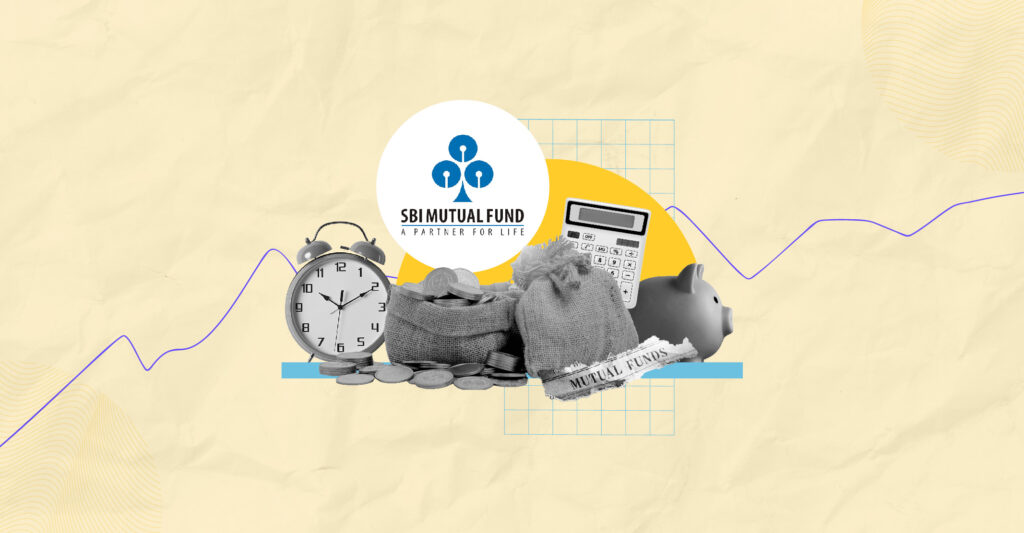Last Updated on Sep 19, 2022 by
The SBI Mutual Fund (SBIMF) is the biggest Asset Management Company (AMC) in India based on the Assets Under Management (AUM). As of March 2022, the AUM of SBIMF was Rs. 6,47,067.24 lakh cr. SBIMF offers a host of mutual funds to suit varied investment needs. In this article, we discuss the top 10 SBI Mutual Funds based on their 5-yr CAGR along with their category, expense ratio, and 3-yr CAGR.
Table of Contents
About SBI Mutual Funds
SBI Funds Management Ltd (SBIFML) has a strong lineage tracing back to the well-known state-run State Bank of India (SBI). The fund house is a joint venture between SBI and France-based leading fund management company Amundi. Currently, SBI holds a 63% stake in SBIFMPL and the rest is held by Amundi India Holding, a wholly-owned subsidiary of Amundi Asset Management. Until June 2011, Amundi’s stake was held by Societe Generale Asset Management S.A. (“SGAM”), a subsidiary company of Societe Generale S.A (“SG”).
SBI Funds Management Ltd’s vision is “To be the most trusted and respected Asset Manager.” Its mission has been to make mutual funds a viable investment option in the country. As such, SBIMFL develops need-specific, innovative products, and educates investors about investing in capital markets through mutual funds. SBIMFL not only manages domestic mutual funds for individual investors but also international funds. It also offers portfolio management advisory services for institutional investors.
Top 10 SBI Mutual Funds
Note: The information is dated 19 September 2022. The parameters used to filter the list of top 10 SBI Mutual Funds on Tickertape are:
- Fund house – SBI Funds Management Limited
- AUM
- 3-yr CAGR
- 5-yr CAGR – set from high to low
- Plan – Growth
- Expense ratio
| Name | AUM (Rs. in cr.) | CAGR 3Y | CAGR 5Y | Expense ratio |
| SBI Technology Opp Fund | 2,534.36 | 25.15 | 24.70 | 0.92 |
| SBI Tax Advantage Fund-III | 30.37 | 37.81 | 24.20 | 2.6 |
| SBI LT Advantage Fund-IV | 181.72 | 37.47 | 22.29 | 0 |
| SBI Small Cap Fund | 14,043.87 | 33.49 | 19.86 | 0.72 |
| SBI LT Advantage Fund-III | 58.43 | 30.98 | 16.88 | 0 |
| SBI Consumption Opp Fund | 1,059.95 | 24.82 | 16.37 | 1.26 |
| SBI Contra Fund | 5,827.07 | 31.55 | 15.59 | 1.07 |
| SBI LT Advantage Fund-II | 33.09 | 30.26 | 15.30 | 2.65 |
| SBI Magnum Midcap Fund | 8,043.42 | 32.53 | 15.22 | 1.01 |
| SBI Focused Equity Fund | 27,450.47 | 20.78 | 15.09 | 0.71 |
SBI Technology Opp Fund
Having an AUM of Rs. 2,534.36 cr., this scheme is a sectoral fund that invests in technology-related instruments. The expense ratio of the fund is 0.9%, while the 3-yr CAGR is 23.15% and the 5-yr CAGR is 24.70%.
SBI Tax Advantage Fund-III
This is an Equity Linked Savings Scheme (ELSS) offered by SBIMF. While the fund size is comparatively smaller at an AUM of Rs. 30.37 cr., the scheme has an expense ratio of 2.6%. The 3-yr and 5-yr CAGRs of the fund are 37.81% and 24.19%, respectively.
SBI LT Advantage Fund-IV
This SBI mutual fund is an equity-linked savings scheme (ELSS) having an AUM of Rs. 181.72 cr. The 3-yr CAGR of the fund is 37.47% and the 5-yr CAGR is 22.29%. An ELSS fund invests in equity instruments and comes with tax benefits.
SBI Small Cap Fund
This fund has an AUM of Rs. 14,043.87 cr. and an expense ratio of 0.72%. Talking about the returns, the fund has a 3-yr CAGR of 33.49% and a 5-yr CAGR of 19.86%. The fund invests in small-cap stocks. By nature, smallcap funds are highly risky but also have the potential to generate higher returns.
SBI LT Advantage Fund-III
Having an AUM of Rs. 58.43 cr., this is another ELSS scheme offered by the AMC. While the 3-yr CAGR is 30.98%, the 5-yr CAGR is 16.88%.
SBI Consumption Opp Fund
This is a sectoral fund that focuses on consumption as a theme. The AUM size of the fund is Rs. 1,059.95. and the expense ratio is 1.26%. Talking about the returns, the fund’s 3-yr CAGR is 24.82% and the 5-yr CAGR is 16.36%.
SBI Contra Fund
Having an AUM of Rs. 5,827.07 cr., this contra fund variant of the SBIMF has an expense ratio of 1.07%. The 3-yr and 5-yr CAGRs are 31.55% and 15.58%, respectively. By definition, a contra fund bets against the current market trends and invests in underperforming or depressed assets at the time.
SBI LT Advantage Fund-II
This is another ELSS scheme offered by SBI Mutual Funds that has an AUM of Rs. 33.09 cr. The expense ratio of the fund is 2.65% and the 3-yr and 5-yr CAGRs are 30.26% and 15.30%, respectively.
SBI Magnum Midcap Fund
This is a midcap fund offered by the SBIMF, this fund has an AUM of Rs. 8,043.42 cr. and an expense ratio of 1.01%. The 3-yr and 5-yr CAGRs are 32.53% and 15.22%, respectively.
SBI Focused Equity Fund
This is a focused fund having an AUM of Rs. 27,450.47 cr. and an expense ratio of 0.71%. The 3-yr and 5-yr CAGRs are 20.78% and 15.09%, respectively. By definition, a focused mutual fund invests in limited stocks belonging to limited sectors.
Conclusion
Depending on the underlying assets, mutual funds are of various types – equity funds, ELSS, focused funds, sectoral funds, and so on. So if you are wondering which SBI mutual fund is the best, the answer depends on factors subject to your investment objective, risk appetite, and return expectation. Do you want to accumulate wealth over the long term? You can consider equity funds. And if you wish to enjoy attractive returns along with tax benefits, ELSS can be a suitable option. Before investing in any mutual fund scheme, compare it with the peers of other fund houses to choose the best one.
Tickertape’s Mutual Fund Screener helps you filter funds based on various parameters such as historical returns, rolling returns, volatility, risk, AUM size, and so on. You can further evaluate the results using the respective Mutual Funds on Tickertape.
FAQs
How to invest in an SBI mutual fund?
There are two ways of investing in SBI mutual funds. One, directly via the fund house – online via the website or offline by visiting the fund house. Second, via an SBI mutual fund distributor. The second option is suitable for investors that don’t have a sound understanding of how mutual funds work and need expert advice when choosing a scheme.
Should you choose an SBI Mutual Fund solely based on its AUM size?
The AUM is nothing but the size of the fund, which may not have a bearing on its returns. A smaller fund may perform better compared to a larger one and vice versa depending on various factors such as the fund manager’s expertise, the credit rating of the underlying assets, maturity period, and interest rate. So, choosing a mutual fund solely based on AUM may not give you desired results.
Which type of SBI Mutual Fund should I invest in?
It depends on various factors such as your financial goal, investment horizon and risk. If you have a high-risk appetite and want to create long term wealth, you can consider equity funds. Alternatively, you can consider debt funds if earning moderate returns by taking a moderate risk is your goal. However, if you need quick access to your funds for liquidity purposes and are not looking to earn high returns, you could consider investing in liquid funds. Similarly, if you want to enjoy the best of both equity and debt, you can consider investing in hybrid funds.




